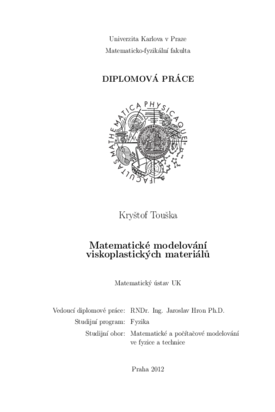Matematické modelování viskoplastických materiálů
Matematické modelování viskoplastických materiálů
diplomová práce (OBHÁJENO)

Zobrazit/
Trvalý odkaz
http://hdl.handle.net/20.500.11956/40823Identifikátory
SIS: 96333
Kolekce
- Kvalifikační práce [10690]
Autor
Vedoucí práce
Oponent práce
Stebel, Jan
Fakulta / součást
Matematicko-fyzikální fakulta
Obor
Matematické a počítačové modelování ve fyzice a technice
Katedra / ústav / klinika
Matematický ústav UK
Datum obhajoby
6. 9. 2012
Nakladatel
Univerzita Karlova, Matematicko-fyzikální fakultaJazyk
Angličtina
Známka
Výborně
Klíčová slova (česky)
viskoplasticita, Binghamova tekutina, MKP, prouděníKlíčová slova (anglicky)
visco-plasticity, Bingham fluid, FEM, flowPráce obsahuje v první části úvod do viskoplasticity a přehled řešených problémů. Ve druhé kapitole je odvozen konstitutivní vztah pro Binghamovu tekutinu a předveden postup důkazu existence a jednoznačnosti klasickou variační metodou. Tento postup je porovnán s postupem skrze moderní implicitní teorii. V závěrečné části je nejprve proveden přehled užitých formulací a použitý soft- ware. Následuje hlavní část s výsledky numerických simulací, jak za účelem srovnání jednotlivých přístupů, tak pro ověření zvoleného přístupu ve složitějších simulacích. Předpokládá se možná aplikace testovaných přístupů na jiné typy materiálů. 1
In the first chapter of the thesis we present an introduction to the visco- plasticity and overview of the presented problems. The constitutive relation for Bingham fluid is derived and in the second chapter. Further there is demon- strated a procedure of proving existence and uniqueness with classical varia- tional method. This method is compared with the same process using modern implicit theory. The last chapter starts with summary of used problem formu- lations and used software. It is then followed by the main part with results of numerical simulations, both for the purpose of used formulations comparison and then verification of the preferred one in more complicated simulations. We expect a possible application of tested approaches on different materials. 1
